Motivation Theories: Practical Applications in the Modern Workplace
VerifiedAdded on 2023/06/12
|7
|2006
|460
Essay
AI Summary
This essay provides a comprehensive analysis of motivation theories and their practical application in the modern workplace. It begins by defining motivation and highlighting its importance in today's dynamic business environment. The essay then delves into various motivational theories, categorizing them into content and process theories. Content theories discussed include Maslow's hierarchy of needs, explaining the five levels of human needs and how they can be met in the workplace, and Herzberg's two-factor theory, differentiating between hygiene and motivational factors. Process theories are explored through Victor Vroom's Expectancy Theory, emphasizing valence, expectations, and instrumentality. The essay concludes that adopting motivation theories is crucial for achieving high organizational performance and productivity, stressing the importance of rewarding, evaluating, and motivating employees to reach their full potential, with a call to action to explore more solved assignments on Desklib.
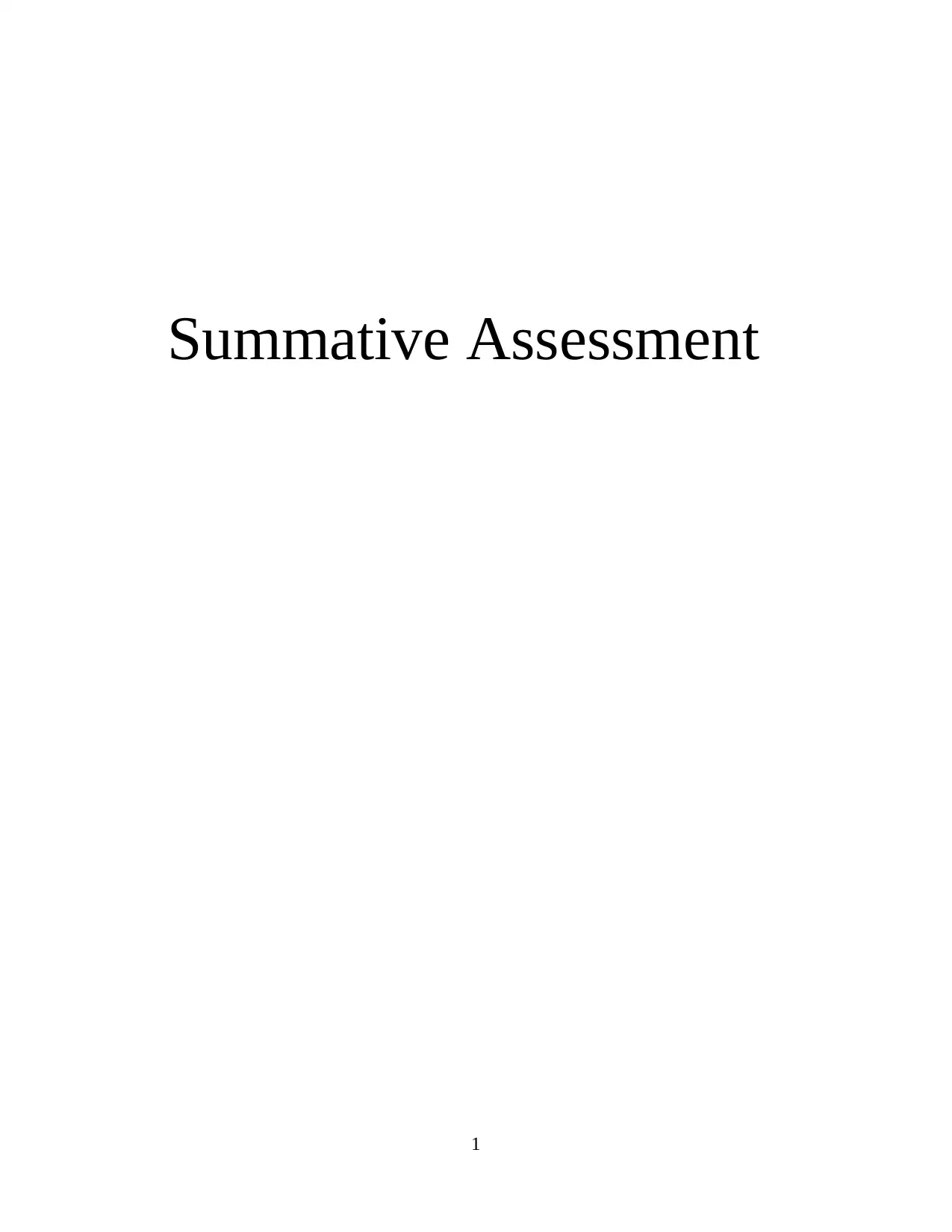
Summative Assessment
1
1
Paraphrase This Document
Need a fresh take? Get an instant paraphrase of this document with our AI Paraphraser
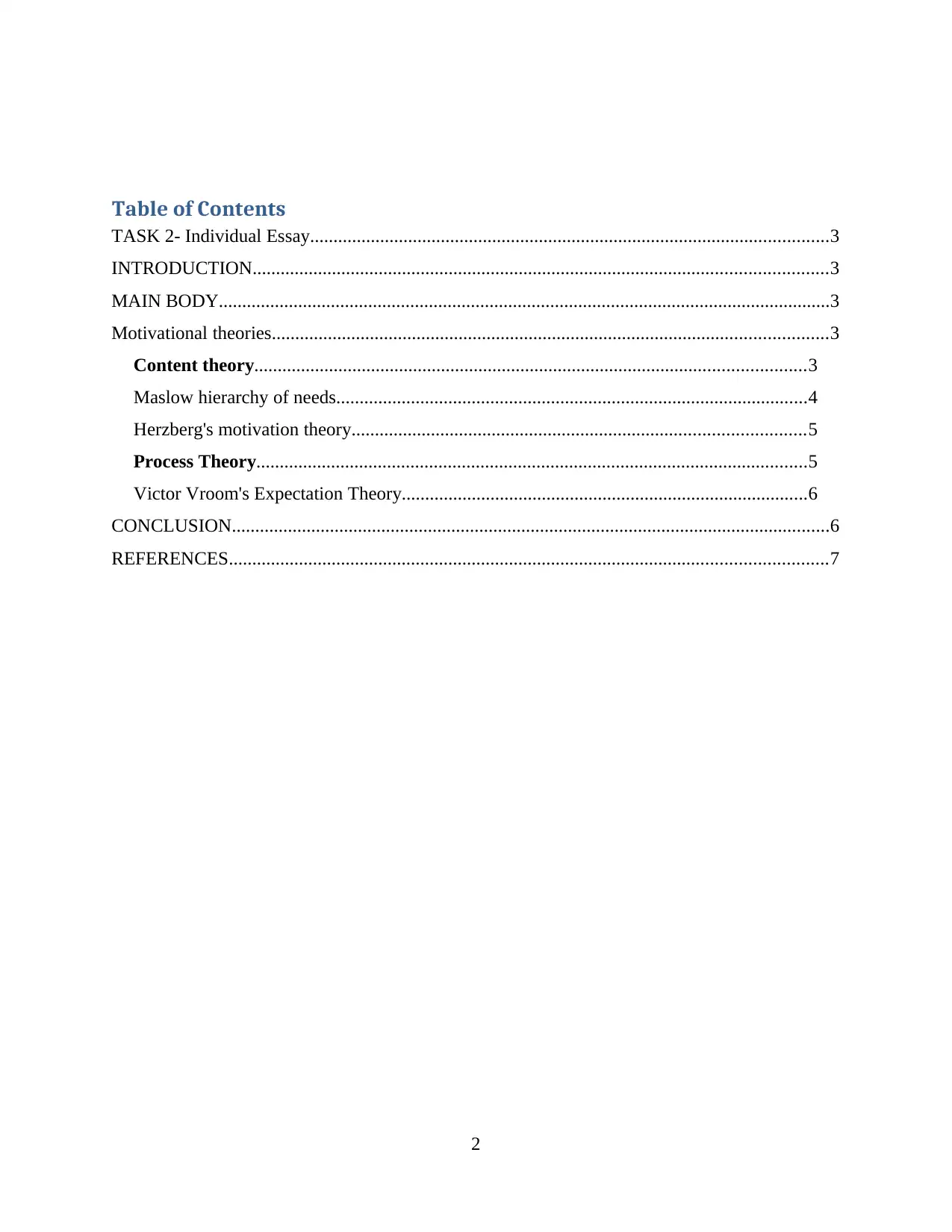
Table of Contents
TASK 2- Individual Essay...............................................................................................................3
INTRODUCTION...........................................................................................................................3
MAIN BODY...................................................................................................................................3
Motivational theories.......................................................................................................................3
Content theory......................................................................................................................3
Maslow hierarchy of needs.....................................................................................................4
Herzberg's motivation theory.................................................................................................5
Process Theory......................................................................................................................5
Victor Vroom's Expectation Theory.......................................................................................6
CONCLUSION................................................................................................................................6
REFERENCES................................................................................................................................7
2
TASK 2- Individual Essay...............................................................................................................3
INTRODUCTION...........................................................................................................................3
MAIN BODY...................................................................................................................................3
Motivational theories.......................................................................................................................3
Content theory......................................................................................................................3
Maslow hierarchy of needs.....................................................................................................4
Herzberg's motivation theory.................................................................................................5
Process Theory......................................................................................................................5
Victor Vroom's Expectation Theory.......................................................................................6
CONCLUSION................................................................................................................................6
REFERENCES................................................................................................................................7
2
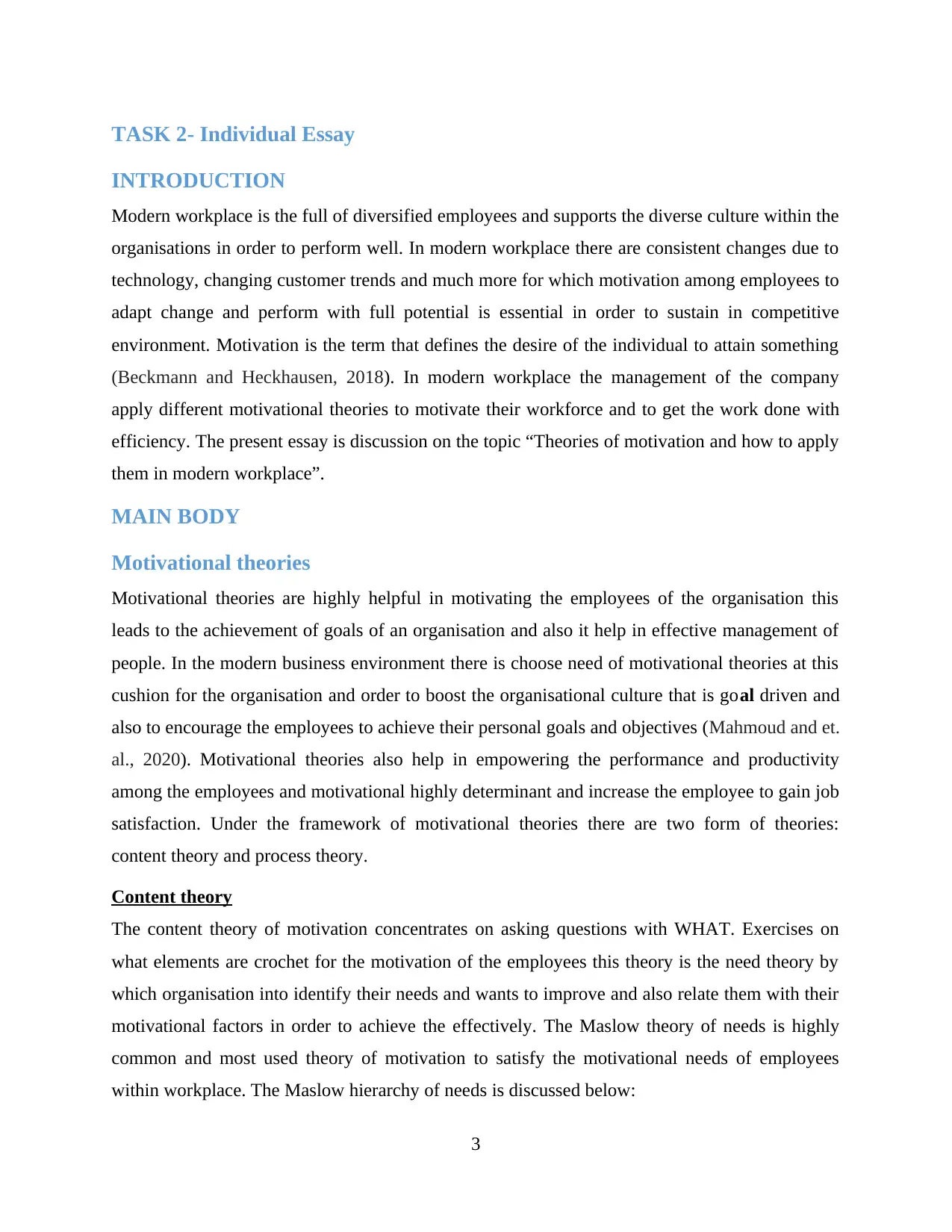
TASK 2- Individual Essay
INTRODUCTION
Modern workplace is the full of diversified employees and supports the diverse culture within the
organisations in order to perform well. In modern workplace there are consistent changes due to
technology, changing customer trends and much more for which motivation among employees to
adapt change and perform with full potential is essential in order to sustain in competitive
environment. Motivation is the term that defines the desire of the individual to attain something
(Beckmann and Heckhausen, 2018). In modern workplace the management of the company
apply different motivational theories to motivate their workforce and to get the work done with
efficiency. The present essay is discussion on the topic “Theories of motivation and how to apply
them in modern workplace”.
MAIN BODY
Motivational theories
Motivational theories are highly helpful in motivating the employees of the organisation this
leads to the achievement of goals of an organisation and also it help in effective management of
people. In the modern business environment there is choose need of motivational theories at this
cushion for the organisation and order to boost the organisational culture that is goal driven and
also to encourage the employees to achieve their personal goals and objectives (Mahmoud and et.
al., 2020). Motivational theories also help in empowering the performance and productivity
among the employees and motivational highly determinant and increase the employee to gain job
satisfaction. Under the framework of motivational theories there are two form of theories:
content theory and process theory.
Content theory
The content theory of motivation concentrates on asking questions with WHAT. Exercises on
what elements are crochet for the motivation of the employees this theory is the need theory by
which organisation into identify their needs and wants to improve and also relate them with their
motivational factors in order to achieve the effectively. The Maslow theory of needs is highly
common and most used theory of motivation to satisfy the motivational needs of employees
within workplace. The Maslow hierarchy of needs is discussed below:
3
INTRODUCTION
Modern workplace is the full of diversified employees and supports the diverse culture within the
organisations in order to perform well. In modern workplace there are consistent changes due to
technology, changing customer trends and much more for which motivation among employees to
adapt change and perform with full potential is essential in order to sustain in competitive
environment. Motivation is the term that defines the desire of the individual to attain something
(Beckmann and Heckhausen, 2018). In modern workplace the management of the company
apply different motivational theories to motivate their workforce and to get the work done with
efficiency. The present essay is discussion on the topic “Theories of motivation and how to apply
them in modern workplace”.
MAIN BODY
Motivational theories
Motivational theories are highly helpful in motivating the employees of the organisation this
leads to the achievement of goals of an organisation and also it help in effective management of
people. In the modern business environment there is choose need of motivational theories at this
cushion for the organisation and order to boost the organisational culture that is goal driven and
also to encourage the employees to achieve their personal goals and objectives (Mahmoud and et.
al., 2020). Motivational theories also help in empowering the performance and productivity
among the employees and motivational highly determinant and increase the employee to gain job
satisfaction. Under the framework of motivational theories there are two form of theories:
content theory and process theory.
Content theory
The content theory of motivation concentrates on asking questions with WHAT. Exercises on
what elements are crochet for the motivation of the employees this theory is the need theory by
which organisation into identify their needs and wants to improve and also relate them with their
motivational factors in order to achieve the effectively. The Maslow theory of needs is highly
common and most used theory of motivation to satisfy the motivational needs of employees
within workplace. The Maslow hierarchy of needs is discussed below:
3
⊘ This is a preview!⊘
Do you want full access?
Subscribe today to unlock all pages.

Trusted by 1+ million students worldwide
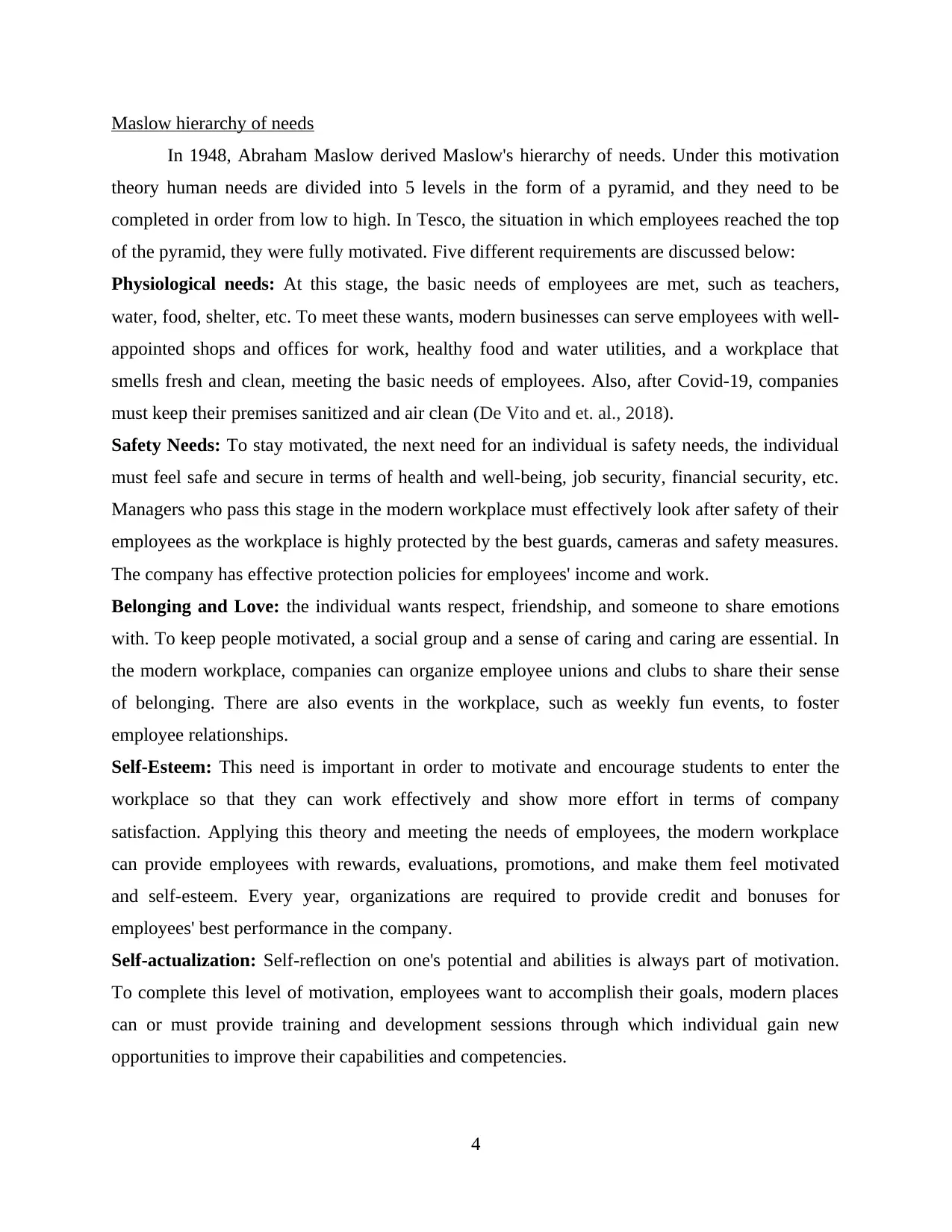
Maslow hierarchy of needs
In 1948, Abraham Maslow derived Maslow's hierarchy of needs. Under this motivation
theory human needs are divided into 5 levels in the form of a pyramid, and they need to be
completed in order from low to high. In Tesco, the situation in which employees reached the top
of the pyramid, they were fully motivated. Five different requirements are discussed below:
Physiological needs: At this stage, the basic needs of employees are met, such as teachers,
water, food, shelter, etc. To meet these wants, modern businesses can serve employees with well-
appointed shops and offices for work, healthy food and water utilities, and a workplace that
smells fresh and clean, meeting the basic needs of employees. Also, after Covid-19, companies
must keep their premises sanitized and air clean (De Vito and et. al., 2018).
Safety Needs: To stay motivated, the next need for an individual is safety needs, the individual
must feel safe and secure in terms of health and well-being, job security, financial security, etc.
Managers who pass this stage in the modern workplace must effectively look after safety of their
employees as the workplace is highly protected by the best guards, cameras and safety measures.
The company has effective protection policies for employees' income and work.
Belonging and Love: the individual wants respect, friendship, and someone to share emotions
with. To keep people motivated, a social group and a sense of caring and caring are essential. In
the modern workplace, companies can organize employee unions and clubs to share their sense
of belonging. There are also events in the workplace, such as weekly fun events, to foster
employee relationships.
Self-Esteem: This need is important in order to motivate and encourage students to enter the
workplace so that they can work effectively and show more effort in terms of company
satisfaction. Applying this theory and meeting the needs of employees, the modern workplace
can provide employees with rewards, evaluations, promotions, and make them feel motivated
and self-esteem. Every year, organizations are required to provide credit and bonuses for
employees' best performance in the company.
Self-actualization: Self-reflection on one's potential and abilities is always part of motivation.
To complete this level of motivation, employees want to accomplish their goals, modern places
can or must provide training and development sessions through which individual gain new
opportunities to improve their capabilities and competencies.
4
In 1948, Abraham Maslow derived Maslow's hierarchy of needs. Under this motivation
theory human needs are divided into 5 levels in the form of a pyramid, and they need to be
completed in order from low to high. In Tesco, the situation in which employees reached the top
of the pyramid, they were fully motivated. Five different requirements are discussed below:
Physiological needs: At this stage, the basic needs of employees are met, such as teachers,
water, food, shelter, etc. To meet these wants, modern businesses can serve employees with well-
appointed shops and offices for work, healthy food and water utilities, and a workplace that
smells fresh and clean, meeting the basic needs of employees. Also, after Covid-19, companies
must keep their premises sanitized and air clean (De Vito and et. al., 2018).
Safety Needs: To stay motivated, the next need for an individual is safety needs, the individual
must feel safe and secure in terms of health and well-being, job security, financial security, etc.
Managers who pass this stage in the modern workplace must effectively look after safety of their
employees as the workplace is highly protected by the best guards, cameras and safety measures.
The company has effective protection policies for employees' income and work.
Belonging and Love: the individual wants respect, friendship, and someone to share emotions
with. To keep people motivated, a social group and a sense of caring and caring are essential. In
the modern workplace, companies can organize employee unions and clubs to share their sense
of belonging. There are also events in the workplace, such as weekly fun events, to foster
employee relationships.
Self-Esteem: This need is important in order to motivate and encourage students to enter the
workplace so that they can work effectively and show more effort in terms of company
satisfaction. Applying this theory and meeting the needs of employees, the modern workplace
can provide employees with rewards, evaluations, promotions, and make them feel motivated
and self-esteem. Every year, organizations are required to provide credit and bonuses for
employees' best performance in the company.
Self-actualization: Self-reflection on one's potential and abilities is always part of motivation.
To complete this level of motivation, employees want to accomplish their goals, modern places
can or must provide training and development sessions through which individual gain new
opportunities to improve their capabilities and competencies.
4
Paraphrase This Document
Need a fresh take? Get an instant paraphrase of this document with our AI Paraphraser
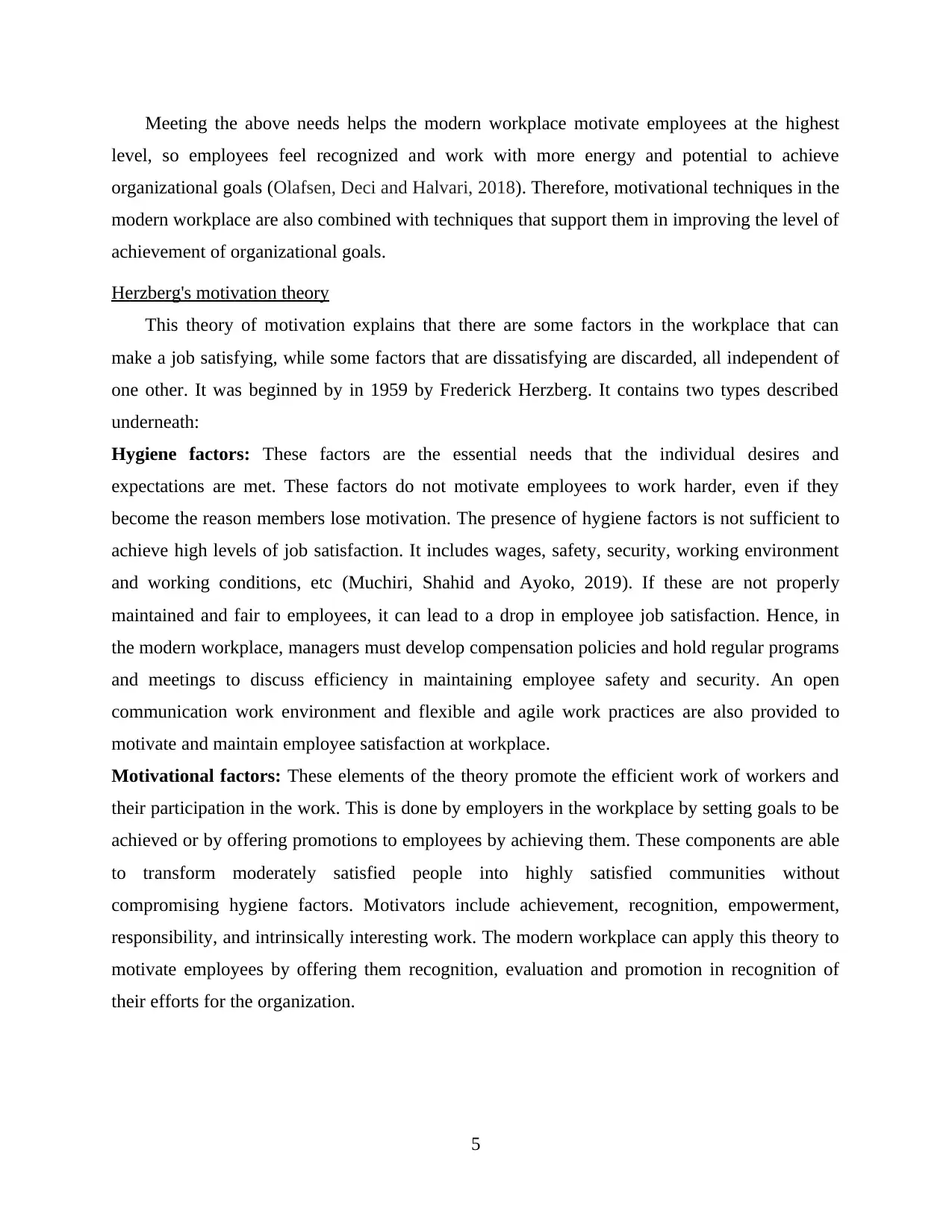
Meeting the above needs helps the modern workplace motivate employees at the highest
level, so employees feel recognized and work with more energy and potential to achieve
organizational goals (Olafsen, Deci and Halvari, 2018). Therefore, motivational techniques in the
modern workplace are also combined with techniques that support them in improving the level of
achievement of organizational goals.
Herzberg's motivation theory
This theory of motivation explains that there are some factors in the workplace that can
make a job satisfying, while some factors that are dissatisfying are discarded, all independent of
one other. It was beginned by in 1959 by Frederick Herzberg. It contains two types described
underneath:
Hygiene factors: These factors are the essential needs that the individual desires and
expectations are met. These factors do not motivate employees to work harder, even if they
become the reason members lose motivation. The presence of hygiene factors is not sufficient to
achieve high levels of job satisfaction. It includes wages, safety, security, working environment
and working conditions, etc (Muchiri, Shahid and Ayoko, 2019). If these are not properly
maintained and fair to employees, it can lead to a drop in employee job satisfaction. Hence, in
the modern workplace, managers must develop compensation policies and hold regular programs
and meetings to discuss efficiency in maintaining employee safety and security. An open
communication work environment and flexible and agile work practices are also provided to
motivate and maintain employee satisfaction at workplace.
Motivational factors: These elements of the theory promote the efficient work of workers and
their participation in the work. This is done by employers in the workplace by setting goals to be
achieved or by offering promotions to employees by achieving them. These components are able
to transform moderately satisfied people into highly satisfied communities without
compromising hygiene factors. Motivators include achievement, recognition, empowerment,
responsibility, and intrinsically interesting work. The modern workplace can apply this theory to
motivate employees by offering them recognition, evaluation and promotion in recognition of
their efforts for the organization.
5
level, so employees feel recognized and work with more energy and potential to achieve
organizational goals (Olafsen, Deci and Halvari, 2018). Therefore, motivational techniques in the
modern workplace are also combined with techniques that support them in improving the level of
achievement of organizational goals.
Herzberg's motivation theory
This theory of motivation explains that there are some factors in the workplace that can
make a job satisfying, while some factors that are dissatisfying are discarded, all independent of
one other. It was beginned by in 1959 by Frederick Herzberg. It contains two types described
underneath:
Hygiene factors: These factors are the essential needs that the individual desires and
expectations are met. These factors do not motivate employees to work harder, even if they
become the reason members lose motivation. The presence of hygiene factors is not sufficient to
achieve high levels of job satisfaction. It includes wages, safety, security, working environment
and working conditions, etc (Muchiri, Shahid and Ayoko, 2019). If these are not properly
maintained and fair to employees, it can lead to a drop in employee job satisfaction. Hence, in
the modern workplace, managers must develop compensation policies and hold regular programs
and meetings to discuss efficiency in maintaining employee safety and security. An open
communication work environment and flexible and agile work practices are also provided to
motivate and maintain employee satisfaction at workplace.
Motivational factors: These elements of the theory promote the efficient work of workers and
their participation in the work. This is done by employers in the workplace by setting goals to be
achieved or by offering promotions to employees by achieving them. These components are able
to transform moderately satisfied people into highly satisfied communities without
compromising hygiene factors. Motivators include achievement, recognition, empowerment,
responsibility, and intrinsically interesting work. The modern workplace can apply this theory to
motivate employees by offering them recognition, evaluation and promotion in recognition of
their efforts for the organization.
5
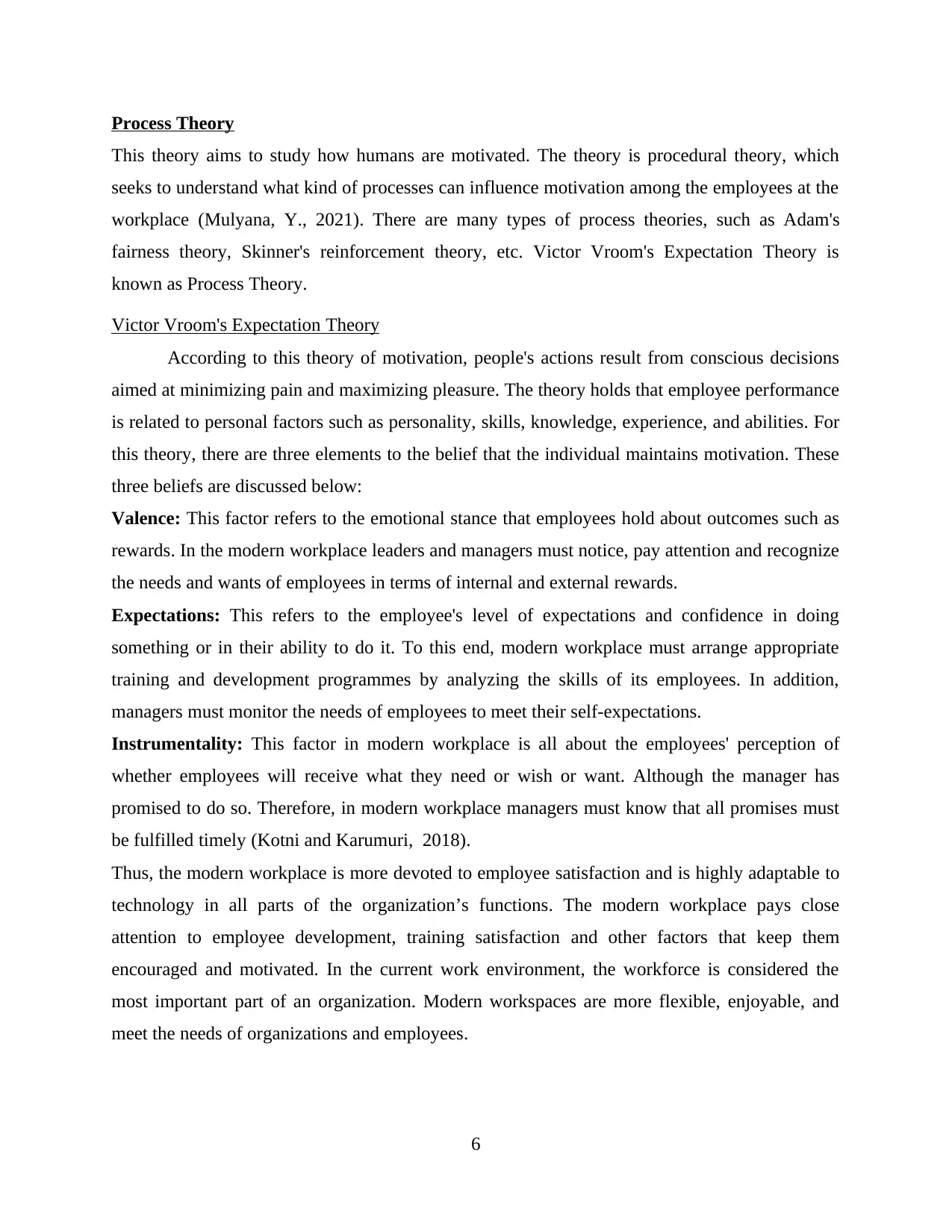
Process Theory
This theory aims to study how humans are motivated. The theory is procedural theory, which
seeks to understand what kind of processes can influence motivation among the employees at the
workplace (Mulyana, Y., 2021). There are many types of process theories, such as Adam's
fairness theory, Skinner's reinforcement theory, etc. Victor Vroom's Expectation Theory is
known as Process Theory.
Victor Vroom's Expectation Theory
According to this theory of motivation, people's actions result from conscious decisions
aimed at minimizing pain and maximizing pleasure. The theory holds that employee performance
is related to personal factors such as personality, skills, knowledge, experience, and abilities. For
this theory, there are three elements to the belief that the individual maintains motivation. These
three beliefs are discussed below:
Valence: This factor refers to the emotional stance that employees hold about outcomes such as
rewards. In the modern workplace leaders and managers must notice, pay attention and recognize
the needs and wants of employees in terms of internal and external rewards.
Expectations: This refers to the employee's level of expectations and confidence in doing
something or in their ability to do it. To this end, modern workplace must arrange appropriate
training and development programmes by analyzing the skills of its employees. In addition,
managers must monitor the needs of employees to meet their self-expectations.
Instrumentality: This factor in modern workplace is all about the employees' perception of
whether employees will receive what they need or wish or want. Although the manager has
promised to do so. Therefore, in modern workplace managers must know that all promises must
be fulfilled timely (Kotni and Karumuri, 2018).
Thus, the modern workplace is more devoted to employee satisfaction and is highly adaptable to
technology in all parts of the organization’s functions. The modern workplace pays close
attention to employee development, training satisfaction and other factors that keep them
encouraged and motivated. In the current work environment, the workforce is considered the
most important part of an organization. Modern workspaces are more flexible, enjoyable, and
meet the needs of organizations and employees.
6
This theory aims to study how humans are motivated. The theory is procedural theory, which
seeks to understand what kind of processes can influence motivation among the employees at the
workplace (Mulyana, Y., 2021). There are many types of process theories, such as Adam's
fairness theory, Skinner's reinforcement theory, etc. Victor Vroom's Expectation Theory is
known as Process Theory.
Victor Vroom's Expectation Theory
According to this theory of motivation, people's actions result from conscious decisions
aimed at minimizing pain and maximizing pleasure. The theory holds that employee performance
is related to personal factors such as personality, skills, knowledge, experience, and abilities. For
this theory, there are three elements to the belief that the individual maintains motivation. These
three beliefs are discussed below:
Valence: This factor refers to the emotional stance that employees hold about outcomes such as
rewards. In the modern workplace leaders and managers must notice, pay attention and recognize
the needs and wants of employees in terms of internal and external rewards.
Expectations: This refers to the employee's level of expectations and confidence in doing
something or in their ability to do it. To this end, modern workplace must arrange appropriate
training and development programmes by analyzing the skills of its employees. In addition,
managers must monitor the needs of employees to meet their self-expectations.
Instrumentality: This factor in modern workplace is all about the employees' perception of
whether employees will receive what they need or wish or want. Although the manager has
promised to do so. Therefore, in modern workplace managers must know that all promises must
be fulfilled timely (Kotni and Karumuri, 2018).
Thus, the modern workplace is more devoted to employee satisfaction and is highly adaptable to
technology in all parts of the organization’s functions. The modern workplace pays close
attention to employee development, training satisfaction and other factors that keep them
encouraged and motivated. In the current work environment, the workforce is considered the
most important part of an organization. Modern workspaces are more flexible, enjoyable, and
meet the needs of organizations and employees.
6
⊘ This is a preview!⊘
Do you want full access?
Subscribe today to unlock all pages.

Trusted by 1+ million students worldwide
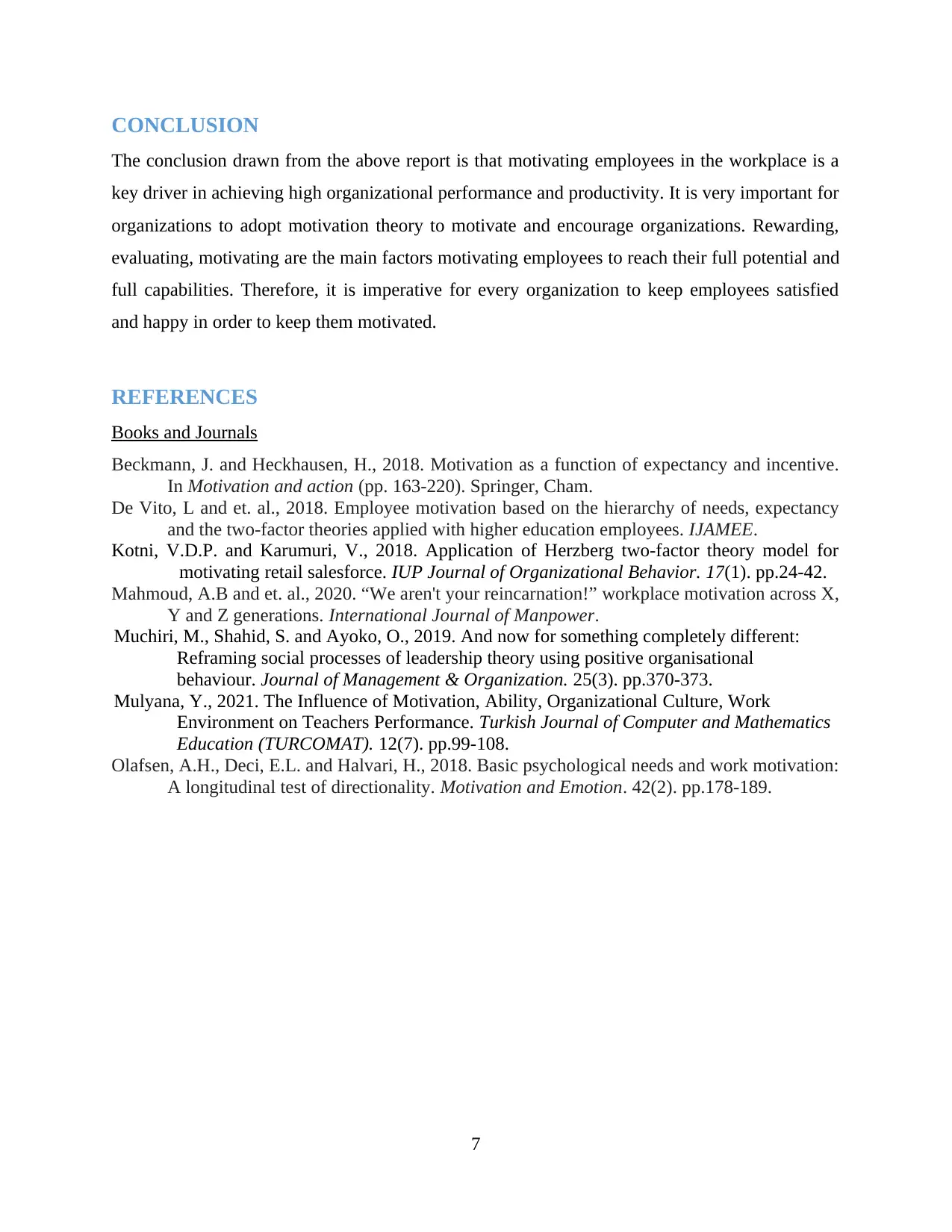
CONCLUSION
The conclusion drawn from the above report is that motivating employees in the workplace is a
key driver in achieving high organizational performance and productivity. It is very important for
organizations to adopt motivation theory to motivate and encourage organizations. Rewarding,
evaluating, motivating are the main factors motivating employees to reach their full potential and
full capabilities. Therefore, it is imperative for every organization to keep employees satisfied
and happy in order to keep them motivated.
REFERENCES
Books and Journals
Beckmann, J. and Heckhausen, H., 2018. Motivation as a function of expectancy and incentive.
In Motivation and action (pp. 163-220). Springer, Cham.
De Vito, L and et. al., 2018. Employee motivation based on the hierarchy of needs, expectancy
and the two-factor theories applied with higher education employees. IJAMEE.
Kotni, V.D.P. and Karumuri, V., 2018. Application of Herzberg two-factor theory model for
motivating retail salesforce. IUP Journal of Organizational Behavior. 17(1). pp.24-42.
Mahmoud, A.B and et. al., 2020. “We aren't your reincarnation!” workplace motivation across X,
Y and Z generations. International Journal of Manpower.
Muchiri, M., Shahid, S. and Ayoko, O., 2019. And now for something completely different:
Reframing social processes of leadership theory using positive organisational
behaviour. Journal of Management & Organization. 25(3). pp.370-373.
Mulyana, Y., 2021. The Influence of Motivation, Ability, Organizational Culture, Work
Environment on Teachers Performance. Turkish Journal of Computer and Mathematics
Education (TURCOMAT). 12(7). pp.99-108.
Olafsen, A.H., Deci, E.L. and Halvari, H., 2018. Basic psychological needs and work motivation:
A longitudinal test of directionality. Motivation and Emotion. 42(2). pp.178-189.
7
The conclusion drawn from the above report is that motivating employees in the workplace is a
key driver in achieving high organizational performance and productivity. It is very important for
organizations to adopt motivation theory to motivate and encourage organizations. Rewarding,
evaluating, motivating are the main factors motivating employees to reach their full potential and
full capabilities. Therefore, it is imperative for every organization to keep employees satisfied
and happy in order to keep them motivated.
REFERENCES
Books and Journals
Beckmann, J. and Heckhausen, H., 2018. Motivation as a function of expectancy and incentive.
In Motivation and action (pp. 163-220). Springer, Cham.
De Vito, L and et. al., 2018. Employee motivation based on the hierarchy of needs, expectancy
and the two-factor theories applied with higher education employees. IJAMEE.
Kotni, V.D.P. and Karumuri, V., 2018. Application of Herzberg two-factor theory model for
motivating retail salesforce. IUP Journal of Organizational Behavior. 17(1). pp.24-42.
Mahmoud, A.B and et. al., 2020. “We aren't your reincarnation!” workplace motivation across X,
Y and Z generations. International Journal of Manpower.
Muchiri, M., Shahid, S. and Ayoko, O., 2019. And now for something completely different:
Reframing social processes of leadership theory using positive organisational
behaviour. Journal of Management & Organization. 25(3). pp.370-373.
Mulyana, Y., 2021. The Influence of Motivation, Ability, Organizational Culture, Work
Environment on Teachers Performance. Turkish Journal of Computer and Mathematics
Education (TURCOMAT). 12(7). pp.99-108.
Olafsen, A.H., Deci, E.L. and Halvari, H., 2018. Basic psychological needs and work motivation:
A longitudinal test of directionality. Motivation and Emotion. 42(2). pp.178-189.
7
1 out of 7
Related Documents
Your All-in-One AI-Powered Toolkit for Academic Success.
+13062052269
info@desklib.com
Available 24*7 on WhatsApp / Email
![[object Object]](/_next/static/media/star-bottom.7253800d.svg)
Unlock your academic potential
Copyright © 2020–2025 A2Z Services. All Rights Reserved. Developed and managed by ZUCOL.



